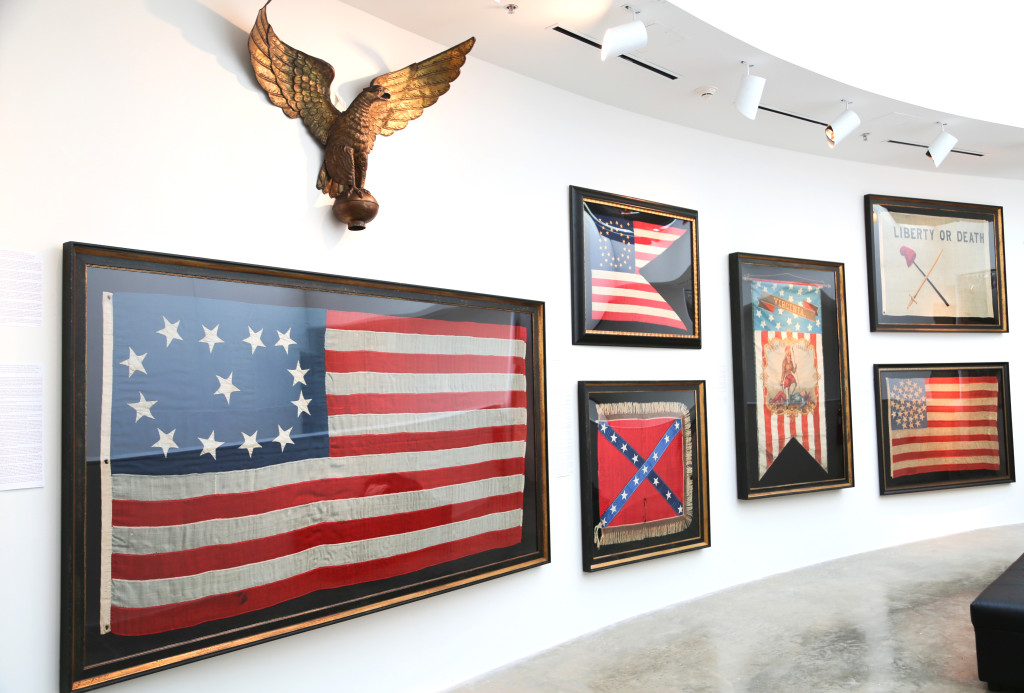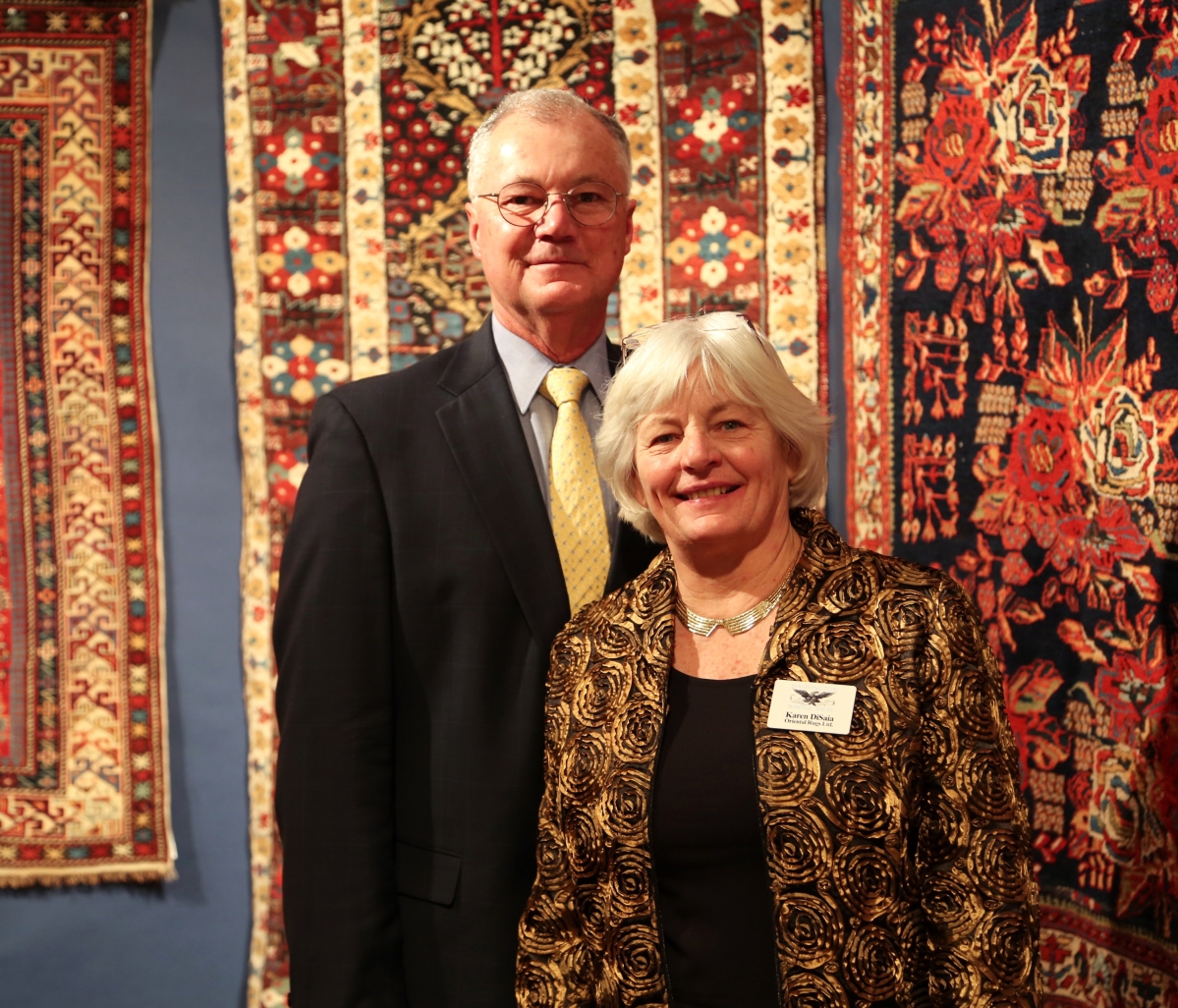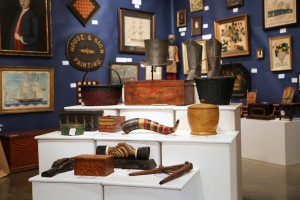WASHINGTON, D.C. – Although the exhibitors are used to it by now, it takes a bit of magic to pull off the Washington Winter Show. The unwieldy floor plan of the Katzen Arts Center at American University makes for one of the most unique experiences in antique buying on the East Coast.
The walls turn and narrowly open into nooks and irregular corners, the concrete floor your sole guide as you meander through three floors of man-made history. It gives attendees a sense of being blissfully lost in exploration, each turn slowly revealing another booth and with it, another one of the 42 dealers’ material, independent style and extensive knowledge. In its 62 years, through poise and purpose, the January 13-15 Washington Winter Show is styled for success in the nation’s capital.
“Washington is a very formal city,” said Karen DiSaia, show manager. “People continue to entertain formally here, so the decorative arts are still in high demand.”
Art, objects and even furniture proved popular in Washington. One buyer scooped up more than 20 pieces of furniture, incoming cabinet members were decorating their new abodes and collectors were, of course, buying whatever they wanted. Historical material still has cachet in a city where history is often made.
“There was an amazing amount of selling at all levels,” said DiSaia. “This show is a little beacon of light.”
The Washington Winter Show puts forth an engaging model in specialist and interest-oriented programming. The “Coco Chanel: A New Portrait by Marion Pike, Paris 1967-1971” loan exhibit marked its debut in the United States at the show’s opening, exploring the relationship between California artist Marion Pike and the famed fashion icon Coco Chanel. While fashion may seem an unlikely partner with antiques, the spirit of Chanel embodied in her famous quote, “fashion fades, only style remains the same,” paired all too well with an industry that has long combined fine taste with material culture and classic, if not historic, style. It was with that in mind that the organizers themed this year’s show “The Art of Style.”
Since its inception, the show has raised more than $8 million in funds for charities. It is the second oldest fundraising antiques show in the country, benefiting three Washington-based organizations: the Bishop John T. Walker School for Boys, Town Hall Education Arts Recreation Campus and the Founders Board of St John Community Services. This year, DiSaia expects that more than $100,000 will be donated through personal underwriting, benefactors and ticket sales.
In addition to attracting existing collectors throughout the mid-Atlantic, the show has put a dedicated foot forward in educating new collectors.
“The show has invested itself in bringing in young people,” said DiSaia. “Three years ago when we started engaging that group, they came to the opening, but weren’t really interested in buying. Two years ago, more came and a few people bought things. Last year, they started buying.”
Within an hour of the opening, this reporter rounded Diana Bittel’s booth to find her wrapping up a gilt carved eagle. The onlooking clients: a young and enthusiastic couple. Before she had even finished wrapping the piece, the wife was asking about a mirror on the nearby wall.
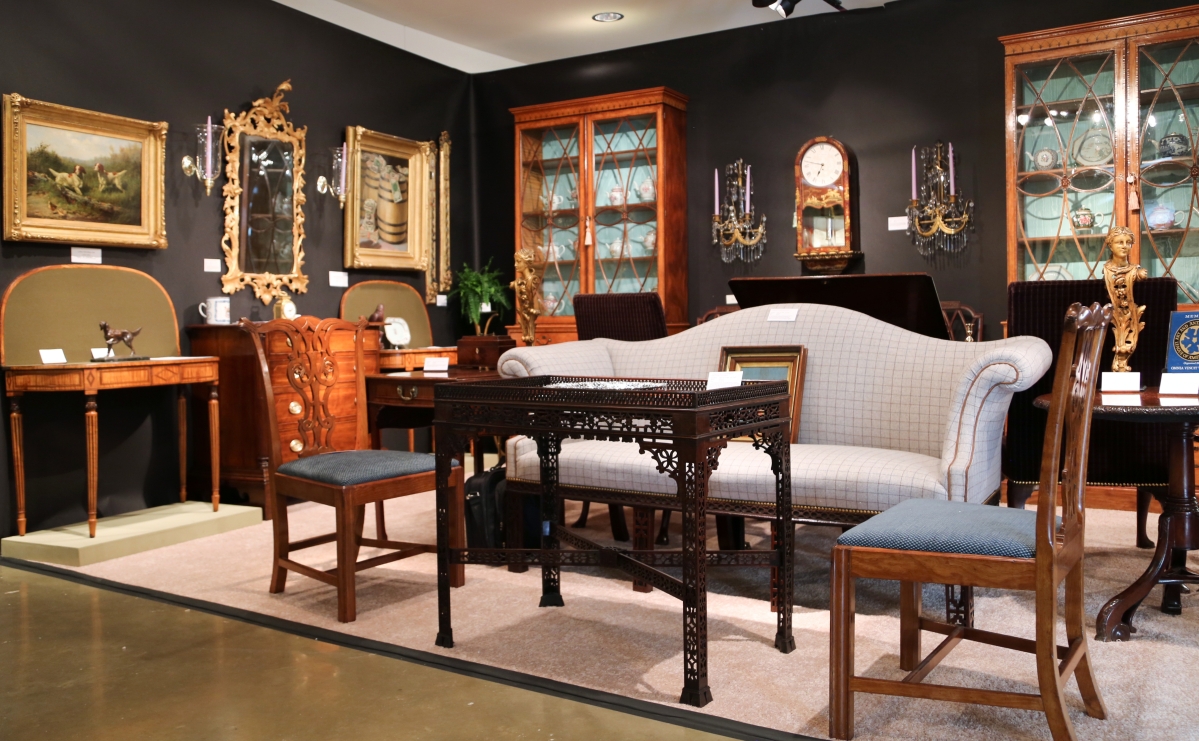
A rare English Chippendale fretwork tea table, circa 1760, in admirable condition sat center stage in the booth of G. Sergeant, Woodbury, Conn.
In a politically minded town, there was perhaps no greater visual than the walls of flag dealer Jeff R. Bridgman, Historic York, Penn. Grand, framed examples of historic American flags with bright, old color rose high along the walls leading up the staircase to the third floor galleries and beyond. The last time Bridgman exhibited at the Washington Winter Show was in 2009.
“It’s wonderful to find such a great flag with a wild pattern,” he said as he nodded toward a rare small-scale 34-star Civil War flag. The unique configuration of the stars was a folky touch that he had never seen before. On the adjoining wall hung a Civil War recruitment broadside with an eight-color image of George Washington flanked by Lady Liberty and Justice, seeking men from New York to fight in a Union regiment bound for Virginia. “It has more colors than anything I’ve ever seen,” said Bridgman. Most broadsides were one color and rarely two.
Fine and significant examples of early furniture were offered in the booth of G. Sergeant, Woodbury, Conn. An impressive English Chippendale fretwork tea table, circa 1760, was a stunning example of delicate craftsmanship in the Chinese style. The triple laminated fretwork was used throughout the piece, from the molded edge gallery to the frame, brackets and legs. The dealer reported never having another in finer condition. Also of note was a vibrant English, George IV rosewood period games table with carved and inlaid faux specimen wood and inset leather. The base featured acanthus carved downswept legs ending in paw feet.
Beverly and Doug Norwood of The Norwoods’ Spirit of America, Timonium, Md., featured a variety of early American objects and folk art. Sitting atop their pedestals were two examples of “tenth anniversary tin” pieces, a top hat and a pair of boots, circa 1850-80. With only a few more pieces, Doug hopes to land a role in Wicked. They also featured a folky chip-carved wood compass, about 12 inches tall, with a dramatic wood glow and a colorful polychromed box with line decoration and interior fittings.
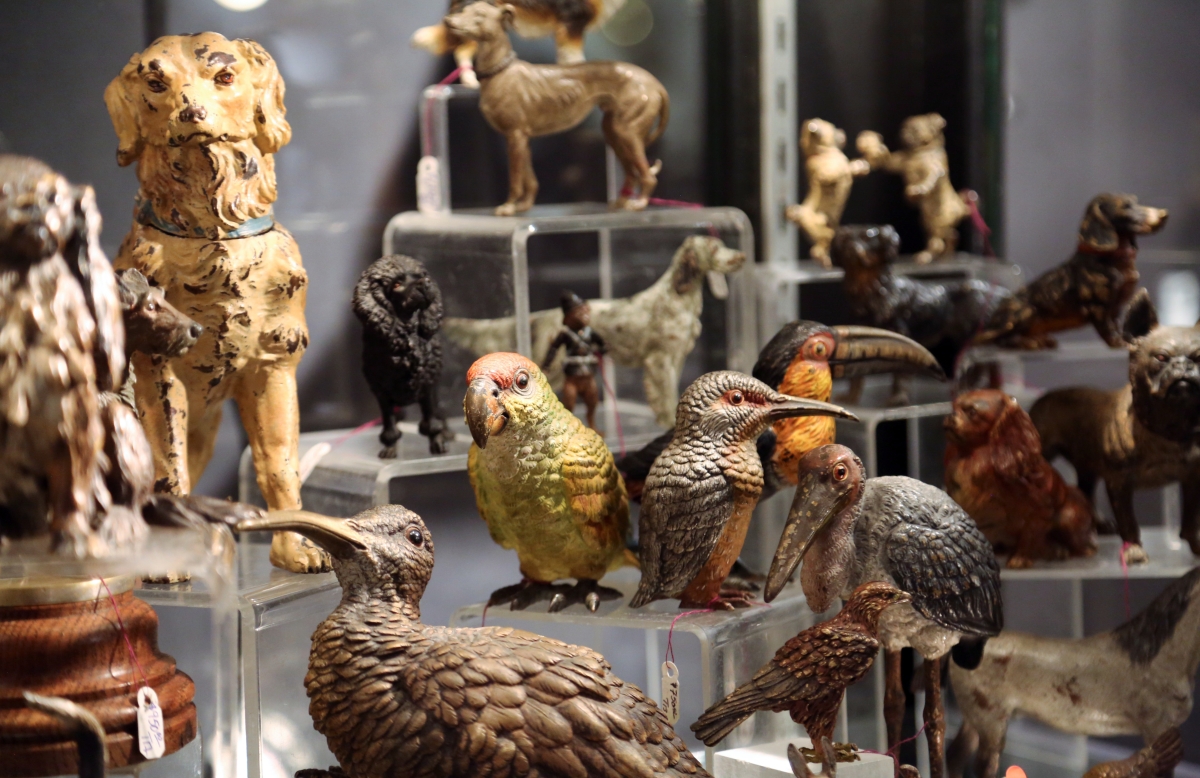
Leatherwood Antiques, Sandwich, Mass., featured its collection of Vienna bronzes. Shown are the more natural works in the form of birds and dogs.
“That one was easy,” said Chuck White of White’s Nautical Antiques, North Yarmouth, Maine, as he pointed at a ship model he had just rerigged with hundreds of lines “from the deck up.” The complexity of the models in White’s collection leaves one in a bit of awe, with the historically accurate details and the construction techniques from the model to an actual-sized ship only differing in physical proportion and not by quality or build practice. In fact, some models see just as much action as the full-size ships. White featured a 19-inch-tall model of a French war frigate made by prisoners of war aboard the same ship. The model was made of chicken, meat and soup bones and circa 1790-1815. White mentioned that it was not unheard of for prisoners to offer the models to their captors for better treatment or, best-case scenario, freedom.
Canton and Nanking porcelain pieces were lit brightly behind the glass at Mellin’s Antiques, Redding Conn. “To have this perfect gilt over the glaze like this is quite rare,” said Gail Mellin, as she pulled out a clobbered Canton platter, from a set of five, with pristine floral gilt overpainting around the border. The platters, made in 1795-1810, featured a timeless style that could easily transfer into modern vogue. The dealers also featured a married pair of Nanking fruit coolers and a set of five graduated Canton canisters from the mid-Nineteenth Century.
A shelf of miniature decoys at A Bird in Hand Antiques, Florham Park, N.J., featured the work of renowned carver Elmer Crowell alongside A.J. Ditman and Roswell Bliss. “The thing about Crowell,” said proprietor Ron Bassin, “he was the only one able to really capture the green glistening off the mallard’s head.” Bassin featured a selection of gulls, canvasbacks, mallards and buffleheads from Crowell.
The works of the French artist Alix Aymé were center to the booth of Fletcher/Copenhaver Fine Art, Fredericksburg, Va. Largely unknown in the United States until an exhibition at the Evergreen Museum & Library at Johns Hopkins University in 2012, Aymé’s works feature the delicate mastery of the lacquered arts as well as masterful works in pen and ink, painting on silk and reverse paintings on glass. Living in Indochina during the French occupation in the 1930s, Aymé taught at the School of Fine Arts in Hanoi, Vietnam. Her time there allowed her to study under highly skilled artisans, resulting in a body of work that crosses the rare intersection of the Asian arts and a more traditional, French formalism.
“It’s our third year in this booth,” said Mo Wajselfish of Leatherwood Antiques, Sandwich, Mass., “and I think we finally got it right.” The dealer brought along his world-class selection of Vienna bronzes that ranged from classic animal forms to the downright whimsical. At the top of the group was an eccentric alligator in a long ribboned top hat with a man’s feet sticking out from his mouth, holding a book and pipe in one arm as if he was just merrily on his way. It is only the second the dealer has ever known.
With nearly every piece of programming sold out throughout the weekend, the show has found an eager following among collectors and enthusiasts who wish to hear from experts in their fields and take part in the annual event. The program included something for everyone: two lectures, two guided walks, appraisals, a luncheon and a 400-attendee jazz night.
Three dealer talks scheduled throughout the weekend gave visitors a chance to talk about a variety of topics. Fine Antique Prints, Wayne, Penn., dealer Denise Delaurentis covered the Parisian style in Georges Goursat’s Belle Epoque characters. Down to the brass tacks of buying, Carol Pinto from Carol Pinto Fine Arts, LLC, New York City, gave a talk on determining the value of art and the outlets that can be used to determine that. Blake Kempard of Solomon Suchard Antiques & Fine Art, Shaker Heights, Ohio, spoke with attendees on the style in vintage French art exhibition posters from the 1950s and 60s.
The Washington Winter Show will be back at the Katzen Arts Center in January 2018. For information, www.washingtonwintershow.org.

